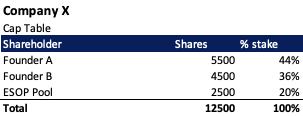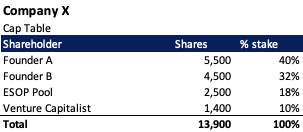
⚠️ Disclaimer
Nothing in this website and ESOP tooklit is intended to be nor should be construed as legal advice. This is an educational project created by students. Please consult your lawyer for legal advice.
EESOP Toolkit
LITE Options ESOP Chatbot
Have any additional questions about ESOPs? Ask our in-house expert, LITE Options Chatbot that uses GenAI coupled with a customized knowledge base to answer questions about ESOPs.
ESOP Template Generator
Ready to make your ESOP template? Use our document automation tool to create a customized ESOP template, for Hong Kong legislation based on your needs.
What Are ESOPs?
Employee Stock Option Plans (‘ESOPs’) are employee benefit plans that provide employees with the opportunity to purchase company shares at a predetermined price over a specified period. These options are often used by employers to incentivize and reward employees.
What Are the Pros and Cons of ESOPs?
✅ Pros
- Cash Conservation: ESOPs free up cash that can be invested back into the company, as they come at no extra direct cost for the employer
- Increased Productivity: ESOPs can lead to an increase in productivity and overall performance improvement for companies with employee stock plans. This is because employees will directly benefit from the success of the company and will feel a sense of ownership
- Alternate Exit Strategy for Aging Owners: ESOPs can be used as an alternative exit strategy for business owners who want to sell their shares and transition flexibly out of the business
- Tax Advantages: ESOPs have certain tax advantages for both owners and employees.
- Attracting Top Talent and Employee Retention: ESOPs can be used to attract top talent and retain employees. This is because employees who participate in ESOPs have a stake in the success of the company and can benefit financially from it
- Higher Job Satisfaction: ESOPs can lead to higher job satisfaction for employees who feel a sense of of ownership.
❌ Cons
Risk of Decision-Making Biased Towards Stock Price: When employees are compensated significantly through stock options, there’s a risk that they might prioritize decisions that temporarily boost stock prices rather than focusing on the long-term health and sustainability of the company.
Limited Motivational Impact Compared to Cash Incentives: While ESOPs can be a valuable tool for aligning employee interests, they may not always be as immediately motivating as direct cash incentives, as the value of stock options is often tied to long-term company performance.
Potential Stock Dilution from Stock Options: One significant con of ESOPs is the potential for stock dilution. When stock options are exercised, it usually results in the creation of new shares, which dilutes the value of existing shares. This dilution can affect all shareholders, potentially reducing the value of their investment.
How To Setup an ESOP?
📃 Typical ESOP agreement in Hong Kong
In Hong Kong, ESOPs have become popular in recent years. More and more companies listing in Hong Kong, especially those from the mainland, have launched ESOPs before or after their IPOs. Typically, ESOPs are structured with “cliffs” that limit the exercising of share options among newer employees. The key features of ESOPs in Hong Kong are:
- In the first year of employment, options cannot be exercised
- In the second year, staff are entitled to 50% of the attributable stock
- The remaining half is accessed in the third year
- Hong Kong levies no tax on the grant/vesting of stock option plans
- Salaries tax does apply when the options are exercised
- Employer and employee are both required to report the amounts to the Inland Revenue Department
⚙️ Setting up the Stock Option Pool
An option pool is a percentage of a company reserved for employees.New companies create option pools by setting aside common stock shares.
- Decide if you want to have a pre-money or post-money option pool
- Pre-money option pool is set up prior to receiving any investment; it dilutes the founders and factors the size of the company into the valuation.
- Post-money option pool is established after the company receives external funding, and it doesn’t factor size into the company’s valuation. Post-money option pools dilute the founders and every shareholder.
- Set aside a pool of outstanding stock, usually around 10%-15% equity. Make sure to keep the pool just big enough for your staffing plans.
- If you make your option pool too large, you will be diluting your shares more than you need to. Yet, the pool should be large enough to attract investors since investors want assurances that your pool is structured to ensure competitive hiring.
- We recommend consulting with a financial profession who can help you determine the right-size of your equity pool.

Employers offer ESOPs through a contract that outlines the terms of the stock options, which could be include in the employment contract.
Example of Setting up a Pre-Money ESOP Pool
1. Capitalization table (i.e, the ownership structure) before ESOPs.

2. Capitalization table after establishing an ESOP Pool of 20%. In this state, ESOPs don’t dilute ownership yet, and this is just a placeholder for the fully diluted ownership stake, i.e. ownership stake after all stock options in the ESOP pool have been exercised.

3. Capitalization table after fundraising $100K from a Venture Capitalist at a pre-money valuation of $900K. At a pre-money valuation of 900K, the Venture Capitalist values your company on its own as being worth 900K, adding the 100K investment, it makes your company worth $1M, which means the Venture Capitalist gets 100K/1M = 10% ownership stake.

Key Considerations for ESOPS
When considering implementing an Employee Stock Ownership Plan (ESOP) for your company, there are several important considerations to keep in mind. ESOPs can be a powerful tool for both ownership succession and employee engagement, but they come with their own set of complexities. Here are some key considerations.
![]()
1. Company Culture and Values
Assess whether the company’s culture and values align with the idea of shared ownership. ESOPs work best in organizations where employees are committed to the company’s success and are willing to actively participate in the ownership structure.

2. Exit Strategy
ESOPs are often used as a succession or exit strategy for founders who want to transition out of the company. Consider your long-term goals and whether an ESOP aligns with your plans for the business’s future.
![]()
3. Employee Buy-In
Gauge the level of interest and support from your employees. An ESOP is most effective when employees are enthusiastic about the idea of becoming owners and are committed to the company’s success.
![]()
4. Feasibility and Affordability
Determine if the company can afford to set up and maintain an ESOP. There are costs associated with creating and managing the plan, and it may involve financing or leveraging the company’s assets to buy out the founder’s ownership stake.
![]()
5. Valuation of the Company
The valuation of the company is a critical factor, as it affects the price at which shares are allocated to employees. Accurate valuation is essential to ensure that both the founder and employees receive fair value for their ownership interests.

6. Legal and Regulatory Compliance
ESOPs are subject to various laws and regulations, including the Employee Retirement Income Security Act (ERISA). Ensure that you understand and comply with all legal requirements and that you have access to professional advisors with expertise in ESOPs.
![]()
7. Communication and Education
Effective communication and education are key to the success of an ESOP. Employees need to understand the plan, its benefits, and their role as owners. Clear and ongoing communication is essential.
![]()
8. Employee Participation and Governance
Determine how employees will participate in the decision-making process and governance of the ESOP. This can include the formation of an employee committee or board of directors.

9. Professional Advisors
Engage qualified professionals, such as ESOP consultants, attorneys, and financial advisors, to help with the planning, implementation, and ongoing management of the ESOP.
HK Company and Securities Law
Two Legislations
- Companies (Winding Up and Miscellaneous Provisions) Ordinance (CWUMPO) Cap.32: Prospectus Regime
- Securities and Futures Ordinance (SFO) Part IV: offers of investments
CWUMPO: CWUMPO requires that an offer of shares to the public must be precedes by a prospectus, which must be authorized for registration. Companies using ESOPs can fall under the private placement exemption: When an offer is made to no more than 50 persons. Other offers made within the previous 12 months are also counted. Practically, this means a maximum of 50 persons every 12 months.
- Must contain a Specific Warning Statement: “WARNING. The contents of this document have not been reviewed by any regulatory authority in Hong Kong. You are advised to exercise caution in relation to the offer. If you are in any doubt about any of the contents of this document, you should obtain independent professional advice.”
- The offer must be addressed to the offeree (employee), and annotated with the employee’s name, and must contain a warning not to copy or pass it to another person
- Subscription to ESOP must be only accepted from the employee themselves
- NO public advertising for the ESOP is allowed. Particularly, the offering document must not be publicized.
Hong Kong Tax Law
Hong Kong maintains a territorial based individual income regime (known as “salaries tax”) with a maximum rate of taxation not exceeding 15% of an individual’s net income. Hong Kong does not tax profits on disposal of capital assets and dividend income is exempt from tax.
There is no tax concessionary treatment for any employee share scheme due to the more straight-forward tax system in Hong Kong. No employee share scheme will need any approval or filing with the Inland Revenue Department of Hong Kong.
Benefits from employee share schemes are taxable perquisite from employment and, unless otherwise specified, will be taxed when they vest. A share option is taxed when it is exercised – the amount of benefit is the difference between the market price when an option is exercised and its exercise price.
For Employees & Directors:
- Report benefits derived from share options or awards for the relevant year
- Report all taxable gains, including gains connected with former employment
- Relevant forms: BIR60 Part 4.1
For Employers:
- Gains of each individual employee and director must be reported for the relevant year of exercise, assignment or release of share option
- Share option gains of employees and directors who left employment (or were terminated) must also be reported (with a control list)
- For the year of granting share option, a list showing names and HKID numbers of the employees and directors, the number of shares granted, and the name of the company must be provided
- For expat employees and directors who were granted share options before their arrival in HK, the employer must submit the following info:
- Number and types of shares in the option
- Money paid for granting of option
- Money required to exercise the option
- Period within which the option must be exercised
- Employee’s gains made during employment must be reported by the employer
- When an employee is about to leave employment without leaving HK, the employer must report any gains made by the employee from the share option
- When an employee is about to leave employment and leave HK for more than 1 month, the employer must report the employee’s gains; if the employee has not yet exercised/assigned/released the share options, the employer must report:
- Number of shares not yet exercised, and the date of grant of shares
- Employee’s gains after termination: The employer must report the employee’s gains alongside his HKID number. This might be the only item of income reported for that employee.
- If the employee has ceased to make gains, or the gain is equal to or less than a single personal allowance, then there is no need to report for that employee.
- Even after the year that the employee leaves, the employer will still have to report for that employee in future years
- Relevant forms: BIR56
Additional matters
- If the shares awarded to an employee are not those of the employer, the tax liability will still be computed in the same way.
- Both employers and employees should keep records for taxable stock-based awards, so that these can be provided to the Assessor for inspection when required.
Hong Kong Emplyoment Law
If an employee is terminated, an ESOP is typically excluded from the damages awarded to the employee. If the employee is granted the shares before vesting, they usually lose the grant. However, the court may still award damages in place of ESOP grants, particularly under constructive dismissal or wrongful termination cases.
Employment Ordinance permits deduction from wages in the following categories:
- Medical benefit scheme
- Superannuation scheme
- Retirement scheme
- Thrift scheme
An ESOP scheme does not fall under the first three categories. It is somewhat similar to a “thrift scheme”, which refers to savings schemes that would not cause risk and provide absolute benefit to the employee. However, since ESOP carries risks due to the nature of investment in the stock market, they cannot be regarded as a “thrift scheme”.
Practical implication: The employer may have to pay full wages to the employees, and then make arrangements to collect their exercise prices when they are payable.
- Illegal wage deductions are a criminal offence, with maximum HK$100,000 fine and 1 year imprisonment.
ESOPs in the United States vs in Hong Kong

Hong Kong
- More requirements when it comes to implementing ESOPs than the United States, such as the Companies (Winding Up and Miscellaneous Provisions) Ordinance.
- The share option is taxed when it is exercised, which is similar to non-qualified stock options yet differs from qualified options.
- There are many requirements for Hong Kong employer to report employee gains, such as relating to expat employees and termination situations compared to fewer requirements in the United States

The United States of America
- Offers tax deductions for employers when offering non-qualified stock options. As ESOPs in the United States are mostly categorized as non-qualified options, this is a stark difference between the two jurisdictions.
- With qualified options in the United States, the option is taxed when the stock is sold, rather than when it is granted or exercised.

LITE Options
Copyright ©️ LITE Options 2023
⚠️ Disclaimer
Nothing in this website and ESOP tooklit is intended to be nor should be construed as legal advice. This is an educational project created by students. Please consult your lawyer for legal advice.